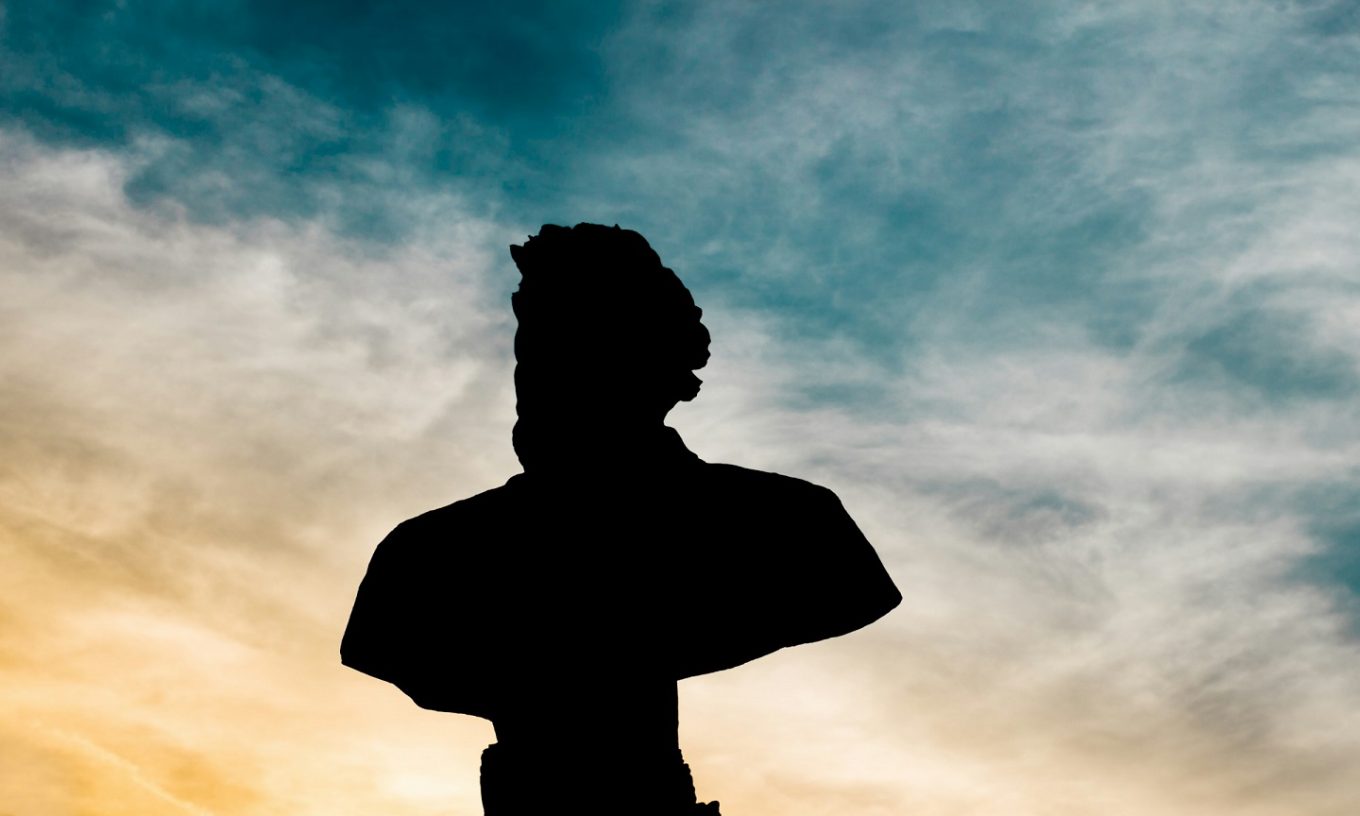In the middle of Tavistock Square in London is a monument of Gandhi seated in a meditative pose. Its face is grim and lined, the body almost skeletal. It always has a fresh garland of orange flowers around its neck and a candle burning at the foot of the pedestal. But this morning I saw a woman in front of it and cursing. She tore the flowers off the statue, threw them in the bushes and after shaking her fist at Gandhi, walked away swearing. I was shocked by her reaction. Wasn’t the statue just a mound of bronze? And what was it doing aside from reigning over the park so peacefully? Obviously, the statue had triggered something in the woman.
Statues are controversial – what they represent and what they serve to remind us of. They emphasise, hide, reveal or quash stories. Where they are placed is as important as what they symbolise. In Tavistock Square, Gandhi is at the centre and the head of Virginia Woolf in the far-left corner. Would it make any difference if the monuments were switched with Virginia presiding over the park and Gandhiji watching from the sidelines? Possibly, the dynamic inside the park would be different. Arguably, the statue of a literary figure has a different vibration from that of a political activist not only because their work and writings are so varied but also because of what they signify and represent.
Several prominent short story writers from India and Pakistan have explored what statues mean to their protagonists and used the interactions to highlight aspects of human nature and moments in history. Characters have reacted with anger, hatred, love and devotion to statues in stories with tragi-comic effect.
One example is RK Narayan. In his dark comedy, Lawley Road, he explored the case of the mistaken identity of a statue and the erasure of colonialism. The story focuses on a prominent statue in the fictional village of Malgudi and whom it should commemorate. The Chairman of the Municipal Council decides to remove the sculpture of Sir Frederick Lawley, from the Lawley Extension, after it was renamed Gandhi Nagar, even though: ‘People had got so used to it that they never bothered to ask whose it was or even to look up. It was generally used by the birds as a perch.’
The twenty feet statue is blasted off its molten lead pedestal, but it is soon discovered it had been a mistake: Sir Lawley, whose statue had been uninstalled, had always been a friend to Malgudi, not to be confused with another Sir Lawley, a ruthless tyrant. The government orders the Chairman to reinstate the monument. The effect is poignant: by describing the confusion around Lawley’s statue, Narayan highlights how he saw the squabbles which are so typical of human nature of no real consequence against the backdrop of the violence of the Partition which was occurring at the same time. The statue is a reminder of British colonialism and the need for citizens to reclaim their identity, but also how the mind becomes ‘colonised’ by the trivial during a crisis.
Also set in the frenzied days of the Partition, is Pakistani author Saadat Hassan Manto’s story The Garland. In this story, a Muslim mob in Lahore attacks the statue of Sir Ganga Ram, a famous Hindu architect and philanthropist. They pelt ‘him’ with sticks, bricks and stones. One man smears the statue with coal tar and another is shot by police as he places a garland of shoes around the monument’s neck. The satire closes with the injured man being rushed off, ‘to be bandaged at Sir Ganga Ram Hospital,’ founded by the very same Ganga Ram whose image he had been wrecking. Manto allows the reader a quick apprehension of an ironic truth, but the characters in his story remain unconscious. The mob, made up of ordinary people, is preoccupied with the dominant story of the ‘villain,’ and all rational thinking is suspended.
In a different type of story also considering statues, Vikas Sarang explores how the statues of gods affect his characters. The magical realism story, The Day the Gods Revolted, is set in Mumbai and told initially from the point of view of a photographer. The action takes place on the tenth day of the festival when the statues of Ganesha are paraded through the streets in a procession before being bathed in the Ganges River. However, before this can happen, all the Ganesha statues jump off their carts and run off, seemingly in a miracle, to avoid the ritual immersion. The characters wonder if it was a blessing or ‘divine wrath,’ and if it was, who exactly were the gods punishing and why? The narrator walks through the streets musing on ‘building, electricity poles and men’ and comments on how ‘they remain the same for years, or change very little, very slowly’ in contrast to shadows which are changing every minute. These simplistic insights forebode his disillusionment which occurs when he sees the Ganesha statues melting into the Ganges, where people are defecating on the banks. Through the different characters’ responses, Sarang explores religious fervour, ignorance and the lack of humanity of those who are seemingly ‘good’ and god-fearing. Religion is subtly critiqued for also overturning a man’s rationality.
The three stories illustrate how authors have used ‘real’ statues in their fiction to highlight issues, which are political, cultural or religious. They also emphasise how a statue can take on an emotional and sometimes irrational significance in the mind of the viewer- and in that sense, the mind is colonised.
These days we are witnessing statues being pushed into rivers, movements being mobilised to have them removed and other monuments being vandalised. We are also seeing statues being constructed by those in authority to emphasise their might and relevance. Statues tell a tale of what myths those in power want entrenched and what those who resist value. In my epistolary short story, ‘Queen Victoria in the Basement,’ I look at what the statue of Queen Victoria in the basement of the Lahore Museum from the point of view of its female caretaker. Aspro, as she is called by her supervisor because she gives him a headache, knows the history of the Empire and the plight of the Indian soldiers who died for the Queen. She compares those events to her life where she is similarly at the mercy of an empire of sorts- the museum corporation- where her working conditions are appalling and she is being exploited. In a dark twist, she makes a necklace of rat bones and crowns the Queen’s statue. In my short story, centering the statue of the Queen allowed me to explore the symbolic legacy of colonialism and highlight a usually marginalised character.
What happens when a statue is not true in its rendition? In her poem ‘Bhagat Singh’s Statue,’ Fahmida Riaz, complains about the monument of Bhagat Singh which was installed in Parliamentary Square in Delhi, saying ‘what a mess they have made,’ because the sculptor chose to show him as an overweight, old man in his sixties, ‘flabby and tired looking,’ with a thick ‘upturned moustaches’, which he was not and did not have when he died at twenty-four. The poet asks , what was the government’s intention in showing the brave, young man in this light, ‘What the hell is this?’ ‘Who the hell is this?’ The poet laments the death of Singh but says his spirit lives on through his statue, and ‘in a heart or two.’ Her poem illustrates how statues in and of themselves are stories. The fact that they exist in a particular shape or form is decided by those in power who want to control and even erase a particular memory and replace it with another.
Statues do many things. They tell or repress a story about the past. They tell us about ourselves. They make us feel uneasy or can inspire. Scenes of sculptural epiphanies and distress, as well as, defiance, acknowledge that engaging with statues is not always easy or enjoyable. They provoke us to search and accept or reject truths they reveal about society and humanity. Statues offer solace in reminding us that if they make us feel ill at ease, we’re certainly not alone. But more than all of this, through narratives where they are at the centre, we learn how they can have a profound influence over our minds, and what we think and believe about ourselves and others. Therefore, there is a caution: not to be carried away by what we see in front of us, but to ask why is it here, what does it represent to those who commissioned it, what do they want us to think, and do we agree or not?
Photo by Ángel Fernández Alonso on Unsplash





